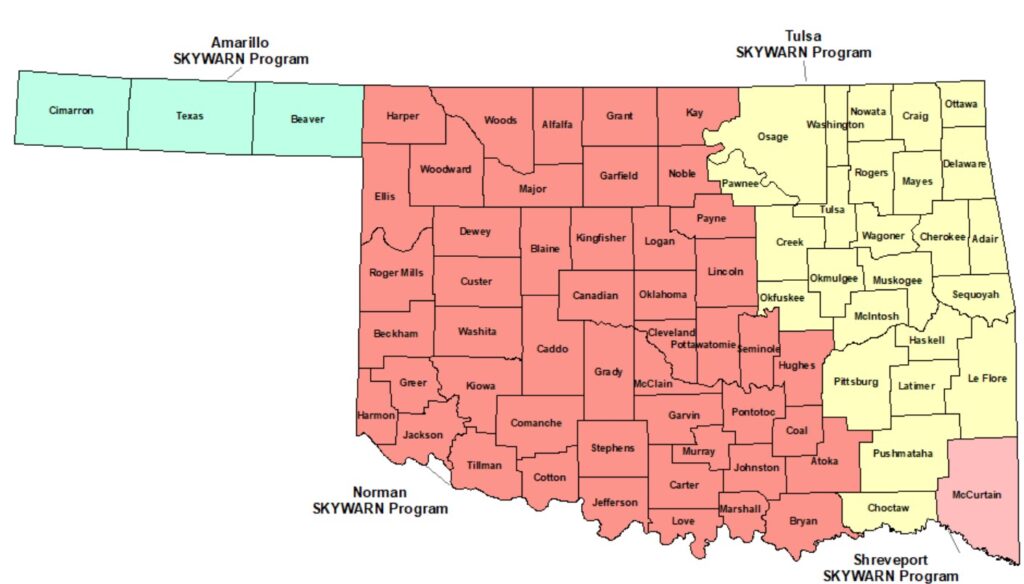SKYWARN® is a volunteer program of the National Weather Service that has over 350,000 trained severe weather spotters. These volunteers help keep their local communities safe by providing timely and accurate reports of severe weather to the National Weather Service. The focus of this group is reporting on severe local thunderstorms. In an average year, the United States experiences more than 10,000 severe thunderstorms, 5,000 floods, and more than 1,000 tornadoes.
How do I get started?
Amateur radio operators are great candidates for this service and are encouraged to become a spotter. In Oklahoma, we have four different weather reporting programs. Amarillo, Norman, Tulsa, and Shreveport offices coordinate these programs in our area.

Training is free and typically lasts about 2 hours. You’ll learn:
- Basics of thunderstorm development
- Fundamentals of storm structure
- Identifying potential severe weather features
- Information to report
- How to report information
- Basic severe weather safety
Need help or other local information? If you need help, contact your local Warning Coordination Meteorologist. He or she can help you and let you know about upcoming classes.
Looking for our online program? You also can also take our free online spotter program. Some offices also ask that you take a local class to learn about weather unique to your area.
Norman Region (NWS OUN)
Many people ask how they can become a member of Skywarn. In most cases, Skywarn isn’t really something you become a member of. Skywarn is a concept based on having citizen volunteers help their community and the NWS by observing and reporting hazardous weather occurring in their area. Anyone can be a storm spotter and submit reports directly to the NWS. If you are interested in becoming a member of an official local Skywarn storm spotter network, you’ll probably want to contact your city or county emergency management office for information. Many communities have organized networks of storm spotters, often made up of amateur radio operators, fire departments, law enforcement, or other volunteers. These local networks may have very specific training and membership requirements, so check with your local officials to see how you might be able to get involved.
Steps to Becoming An OUN Skywarn Spotter
- Complete the 2 Online National Skywarn Training Modules.The courses are “The Role of the Skywarn Spotter” and “Skywarn Spotter Convective Basics”. The courses will require you to register with the Meted Training Site.
- Review our basic spotter training modules.They are available on our YouTube Spotter Training playlist.
- Participate in one of our spotter training webinarsor attend one of our regional training sessions in your area. Check our latest training schedule for dates and locations.
- Register with Spotter Network.This is not required, but Spotter Network gives you additional training and other methods for contacting us.
- For information about joining a local spotter network, contact your local Emergency Management office.Your local and county officials can provide additional information about how spotter groups are organized in your community. Many spotter groups in the small communities in central/western Oklahoma and western north Texas are led by local volunteer firefighters with assistance from law enforcement, amateur radio operators, and other community volunteers such as CERT volunteer.
The various amateur radio SKYWARN programs are available at these links:
- Cleveland County ARES SKYWARN — https://w5nor.org/skywarn/
Tulsa Region (NWS TUL)
In the Tulsa region, you can find the spotter training schedule at this link.
The Tulsa office also produces a spotter card that is available at this link.
The various amateur radio SKYWARN programs are available at these links:
- Tulsa SKYWARN — http://w5ias.com/wx5tul/
Amarillo Region (NWS AMA)
The Amarillo region has an active amateur radio presence with the AMA NWS, available at this link and their spotter training is listed at this link.
Shreveport Region (NWS SHV)
The Shreveport region spotter and SKYWARN training information is listed at this link.